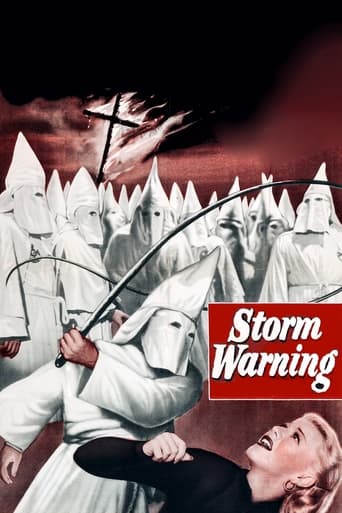billdower
Storm Warning is a real curiosity in terms of its casting – dancer Ginger Rogers, one time favourite partner of Fred Astair, and Doris Day, who went on to become America's favourite virgin/mum-next-door in light-weight comedy movies (while simultaneously achieving world-wide success as a singer), are cast a sisters in a film noir with no singing and dancing but scenes of murder, attempted rape, ritual scourging and domestic violence! Billed as an expose of the Ku Klux Klan the movie has been slated in some quarters for shying away from the real issues: no mention of the racism and sectarianism for which the loathsome organisation is infamous, no black faces in the crown scenes, no real idea of the location of Rock Point, the fictional town where the action is set – all that is explicitly stated is that it isn't New York! The film opens with Ms Rogers, on the way to a marketing assignment somewhere outside of the metropolis, stopping off en-route to visit her sister in small-town USA where, as misfortune would have it, she witness the murder by Klansmen of a 'meddling reporter'. Later, on meeting her sister's husband (Steve Cochran) Ms Rogers recognises him as one of the murderers. For the sake of her sister, who has just discovered she is expecting her first child, Ms Rogers lies at the court hearing claiming she saw nothing, therefore denying county prosecutor Ronald Reagan (yep, the one that became President) the chance of issuing subpoenas to every member of the local Klan chapter in pursuance of a prosecution. Through Ronnie's dialogue and that of the chief clansman and local employer, the film does indeed seem to portray the Klan as a bunch of hoodlums, thugs and petty gangsters whose main crime seems to be evading income tax ¬– as opposed to a quasi-religious organisation hell-bent on spreading hate, distrust and violence. While this does seem to indicate the studio back peddling on its intent to rip aside the veil of mystery surrounding the Klan, there is some truth in the description of its members. If the Klan only attracted law-abiding citizens and fought for its anti-Jew/catholic/black agenda through the ballot box it would be a laughing stock. The fear-inspiring fact of the matter is that this type of hate-fuelled organisation tends to attract hoodlums and thugs who aspire to violence and lust for power. Society can deal with and dismiss the ill-thought-out philosophies of these fringe organisations but it is more difficult to deal with the law-breaking, violent acts which take place in the dead of night perpetrated by cowardly gangsters who hide their faces. Made in 1951, Storm Warning, was the first movie to feature the Klan in such a negative fashion. It is hard-hitting in number of ways – while much of the action seems a little tame to the jaded audiences of 21st century, particularly the domestic violence perpetrated by Hank Rice (Steve Cochran), which is a mere shadow of that of Marlon Brando's Stanley in A Streetcar Named Desire, the scene were Ms Rogers actually vomits in the street having just witnessed the murder remains particularly shocking! While this Warner Bros production falls well short of the studio's best fare there are great performances from the leads and it is a pity the movie is so hard to get hold of – I had to get mine from a guy in Madrid!
MartinHafer
Ginger Rogers is cast as a model (a very OLD model) on her way to see her sister (Doris Day) and her new husband (Steve Cochran). After arriving in the town, she wanders upon an ugly scene--a crowd of Klansmen taking a prisoner from the local jail and killing him vigilante-style in the street. In addition, she sees the identities of two of the men! Following the murder, the county prosecutor (Ronald Reagan) investigates but finds nothing but silence. It's obvious the 'nice' townsfolk participated and many know their identities--but no one is willing to talk. When he learns that Rogers saw the killing, he's excited to finally have a witness--but keeping her alive for the trial may not be easy--especially after her brother-in-law learns that she saw HIM at the killing! A lot more follows--and I won't say more because it could spoil the suspense.In many ways, this is a taut and excellent drama. BUT, it also pulls some of its punches. It's VERY strange that there are no black folks as characters in the film--not even as the victim. Now I am NOT saying the KKK didn't sometimes kill whites, but this was the exception to the rule and completely negates the whole racism angle. It's sad, but the film seemed to want to play it safe by playing it that way. However, while Hollywood was very hesitant to address race, 1949 (when the film was made--though they held it for a bit before release) was a good year with wonderful race films like "Pinky" and "Intruder in the Dust" also coming from rival studios, Twentieth-Century Fox and MGM. Fortunately, the film does manage to rise above this due to an exciting script--especially at the end (which is top-notch). Because of this and a few excellent performances (particularly for Reagan), it's well worth your time.
JoeB131
Now, of course, Ronald Reagan as an actor was eclipsed by Ronald Reagan the President. So no one really talks about his films on their own merits other than to point out he was an actor.This is an interesting film, as it takes on the Ku Klux Klan (which is just called "the Klan" in this film). Ginger Rogers plays a model who witnesses a murder by the Klan on her way to visit her sister (played by Doris Day, of all people) only to find out her husband was one of the Klansmen.Reagan plays a crusading district attorney who challenges the Klan and investigates the murder with vigor.Now, my complaint is that the Klan are the villains, but they are sanitized. YOu get no feeling for WHY the Klan was evil. There's no mention of their racism. (In fact, there is not one black person in the entire film.) Their strength comes in their ability to terrorize white people into shutting up. To top it off, almost none of them have southern accents. (By 1951, the KKK had been pushed back into only the south.) They do have the great scene at the end where Reagan saves Ginger from a flogging, denouncing the Klan members and pointing out that he knew who they were even with the robes and hoods, and denounces them for "desecrating the cross". A nice scene at the end where the Klansmen retreat in a panic and the burning cross falls because one good man said "no".
zeppo1-2
The first 30 minutes of this film are riveting, owing primarily to Ginger Rogers' subtle and restrained performance. She doesn't have much dialog but emotes with body and expression beautifully. The level of tension is palpable. Sadly, that dissipates as the movie rolls on, until the ending where Ginger is in real danger. And, although the many objections that people raise here are not without merit, including the compressed time of the inquest, the lack of continued menace from "the Klan", the odd location setting, I still have to say that this is one of my new favorite movies. There are a lot of subtleties that add to the film.And, it's nice to see Lloyd Gough (who played Mike Axeford on the 1966 Green Hornet TV show) trying to pick up Ginger on the bus.




